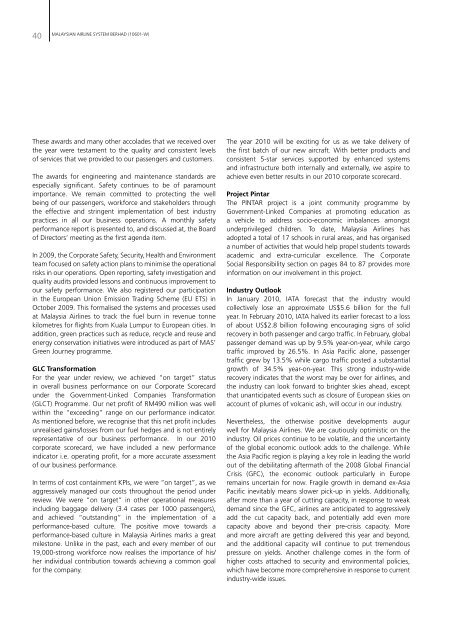ANNUAL REPORT - ChartNexus
ANNUAL REPORT - ChartNexus
ANNUAL REPORT - ChartNexus
You also want an ePaper? Increase the reach of your titles
YUMPU automatically turns print PDFs into web optimized ePapers that Google loves.
40<br />
MALAYSIAN AIRLINE SYSTEM BERHAD (10601-W)<br />
These awards and many other accolades that we received over<br />
the year were testament to the quality and consistent levels<br />
of services that we provided to our passengers and customers.<br />
The awards for engineering and maintenance standards are<br />
especially significant. Safety continues to be of paramount<br />
importance. We remain committed to protecting the well<br />
being of our passengers, workforce and stakeholders through<br />
the effective and stringent implementation of best industry<br />
practices in all our business operations. A monthly safety<br />
performance report is presented to, and discussed at, the Board<br />
of Directors’ meeting as the first agenda item.<br />
In 2009, the Corporate Safety, Security, Health and Environment<br />
team focused on safety action plans to minimise the operational<br />
risks in our operations. Open reporting, safety investigation and<br />
quality audits provided lessons and continuous improvement to<br />
our safety performance. We also registered our participation<br />
in the European Union Emission Trading Scheme (EU ETS) in<br />
October 2009. This formalised the systems and processes used<br />
at Malaysia Airlines to track the fuel burn in revenue tonne<br />
kilometres for flights from Kuala Lumpur to European cities. In<br />
addition, green practices such as reduce, recycle and reuse and<br />
energy conservation initiatives were introduced as part of MAS’<br />
Green Journey programme.<br />
GLC Transformation<br />
For the year under review, we achieved “on target” status<br />
in overall business performance on our Corporate Scorecard<br />
under the Government-Linked Companies Transformation<br />
(GLCT) Programme. Our net profit of RM490 million was well<br />
within the “exceeding” range on our performance indicator.<br />
As mentioned before, we recognise that this net profit includes<br />
unrealised gains/losses from our fuel hedges and is not entirely<br />
representative of our business performance. In our 2010<br />
corporate scorecard, we have included a new performance<br />
indicator i.e. operating profit, for a more accurate assessment<br />
of our business performance.<br />
In terms of cost containment KPIs, we were “on target”, as we<br />
aggressively managed our costs throughout the period under<br />
review. We were “on target” in other operational measures<br />
including baggage delivery (3.4 cases per 1000 passengers),<br />
and achieved “outstanding” in the implementation of a<br />
performance-based culture. The positive move towards a<br />
performance-based culture in Malaysia Airlines marks a great<br />
milestone. Unlike in the past, each and every member of our<br />
19,000-strong workforce now realises the importance of his/<br />
her individual contribution towards achieving a common goal<br />
for the company.<br />
The year 2010 will be exciting for us as we take delivery of<br />
the first batch of our new aircraft. With better products and<br />
consistent 5-star services supported by enhanced systems<br />
and infrastructure both internally and externally, we aspire to<br />
achieve even better results in our 2010 corporate scorecard.<br />
Project Pintar<br />
The PINTAR project is a joint community programme by<br />
Government-Linked Companies at promoting education as<br />
a vehicle to address socio-economic imbalances amongst<br />
underprivileged children. To date, Malaysia Airlines has<br />
adopted a total of 17 schools in rural areas, and has organised<br />
a number of activities that would help propel students towards<br />
academic and extra-curricular excellence. The Corporate<br />
Social Responsibility section on pages 84 to 87 provides more<br />
information on our involvement in this project.<br />
Industry Outlook<br />
In January 2010, IATA forecast that the industry would<br />
collectively lose an approximate US$5.6 billion for the full<br />
year. In February 2010, IATA halved its earlier forecast to a loss<br />
of about US$2.8 billion following encouraging signs of solid<br />
recovery in both passenger and cargo traffic. In February, global<br />
passenger demand was up by 9.5% year-on-year, while cargo<br />
traffic improved by 26.5%. In Asia Pacific alone, passenger<br />
traffic grew by 13.5% while cargo traffic posted a substantial<br />
growth of 34.5% year-on-year. This strong industry-wide<br />
recovery indicates that the worst may be over for airlines, and<br />
the industry can look forward to brighter skies ahead, except<br />
that unanticipated events such as closure of European skies on<br />
account of plumes of volcanic ash, will occur in our industry.<br />
Nevertheless, the otherwise positive developments augur<br />
well for Malaysia Airlines. We are cautiously optimistic on the<br />
industry. Oil prices continue to be volatile, and the uncertainty<br />
of the global economic outlook adds to the challenge. While<br />
the Asia Pacific region is playing a key role in leading the world<br />
out of the debilitating aftermath of the 2008 Global Financial<br />
Crisis (GFC), the economic outlook particularly in Europe<br />
remains uncertain for now. Fragile growth in demand ex-Asia<br />
Pacific inevitably means slower pick-up in yields. Additionally,<br />
after more than a year of cutting capacity, in response to weak<br />
demand since the GFC, airlines are anticipated to aggressively<br />
add the cut capacity back, and potentially add even more<br />
capacity above and beyond their pre-crisis capacity. More<br />
and more aircraft are getting delivered this year and beyond,<br />
and the additional capacity will continue to put tremendous<br />
pressure on yields. Another challenge comes in the form of<br />
higher costs attached to security and environmental policies,<br />
which have become more comprehensive in response to current<br />
industry-wide issues.

















